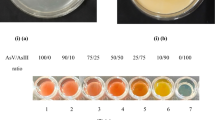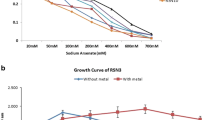Abstract
In the present study, 44 arsenic-resistant bacteria were isolated through serial dilutions on agar plate with concentrations ≥0.05 mM of sodium arsenite and ≥10 mM of sodium arsenate from Mandovi and Zuari—estuarine water systems. The ars genotype characterization in 36 bacterial isolates (resistant to 100 mM of sodium arsenate) revealed that only 17 isolates harboured the arsA (ATPase), B (arsenite permease) and C (arsenate reductase) genes on the plasmid DNA. The arsA, B and C genes were individually detected using PCR in 16, 9 and 13 bacterial isolates respectively. Molecular identification of the 17 isolates bearing the ars genotype was carried using 16S rDNA sequencing. A 1300 bp full length arsB gene encoding arsenite efflux pump and a 409 bp fragment of arsC gene coding for arsenate reductase were isolated from the genera Halomonas and Acinetobacter. Phylogenetic analysis of arsB and arsC genes indicated their close genetic relationship with plasmid borne ars genes of E. coli and arsenate reductase of plant origin. The putative arsenate reductase gene isolated from Acinetobacter species complemented arsenate resistance in E. coli WC3110 and JM109 validating its function. This study dealing with isolation of native arsenic-resistant bacteria and characterization of their ars genes might be useful to develop efficient arsenic detoxification strategies for arsenic contaminated aquifers.



Similar content being viewed by others
References
Achour AR, Bauda P, Billard P (2007) Diversity of arsenite transporter genes from arsenic-resistant soil bacteria. Res Microbiol 158:128–137
Altschul SF, Gish W, Miller W, Myers EW, Lipman DJ (1990) Basic local alignment search tool. J Mol Biol 215:403–410
Anderson CR, Cook GM (2004) Isolation and characterization of arsenate-reducing bacteria from arsenic-contaminated sites in New Zealand. Curr Microbiol 48:341–347
Branco R, Chung AP, Morais PV (2008) Sequencing and expression of two arsenic resistance operons with different functions in the highly arsenic-resistant strain Ochrobactrum tritici SCII24T. BMC Microbiol 8:95
Butcher BG, Deane SM, Rawlings DE (2000) The chromosomal arsenic resistance genes of Thiobacillus ferrooxidans have an unusual arrangement and confer increased arsenic and antimony resistance to Escherichia coli. Appl Environ Microbiol 66:1826–1833
Cai L, Liu G, Rensing C, Wang G (2009) Genes involve in arsenic transformation and resistance associated with different levels of arsenic-contaminated soils. BMC Microbiol 9:1471–2180
Cavalca L, Zanchi R, Corsini A, Colombo M, Romagnoli C, Canzi E, Andreoni V (2010) Arsenic-resistance bacteria associated with roots of the wild Cirsium arvense (L.) plant from an arsenic polluted soil, and screening of potential plant growth-promoting characteristics. Syst Appl Microbiol 33:154–164
Cervantes C, Ji G, Ramirez JL, Silver S (1994) Resistance to arsenic compounds in microorganisms. FEMS Microbiol Rev 15:355–367
Chang JS, Yoon IH, Lee JH, Kim KR, An J, Kim KW (2010) Arsenic detoxification potential of aox genes in arsenite oxidizing bacteria isolated from natural and constructed wetlands in the Republic of Korea. Environ Geochem Health 32:95–105
Chauhan NS, Ranjan R, Purohit HJ, Kalia VC, Sharma R (2009) Identification of genes conferring arsenic resistance to Escherichia coli from an effluent treatment plant sludge metagenomic library. FEMS Microbiol Ecol 67:130–139
Escalante G, Campos VL, Valenzuela C, Yanez J, Zaror C, Mondaca MA (2009) Arsenic resistant bacteria isolated from arsenic contaminated river in the Atacama desert (Chile). Bull Environ Contam Toxicol 83:657–661
Fan H, Su C, Wang Y, Yao J, Zhao K, Wang Y, Wang G (2008) Sedimentary arsenite-oxidizing and arsenate reducing bacteria associated with high arsenic ground water from Shanyin, Northwestern China. J Appl Microbiol 105:529–539
Filali BK, Taoufik J, Zeroual Y, Dzairi FZ, Talbi M, Blaghen M (2000) Waste water bacteria resistant to heavy metals and antibiotics. Curr Microbiol 41:151–156
Hartwig A, Groblinghoff UD, Beyersmann D, Nataranjan AT, Filon R, Mullenders LHF (1997) Interaction of arsenic(III) with nucleotide excision repair in UV-irradiated human fibroblasts. Carcinogenesis 18:399–405
Hughes MF (2002) Arsenic toxicity and its potential mechanisms of action. Toxicol Lett 133:1–16
Jackson CR, Dugas SL (2003) Phylogenetic analysis of bacterial and archeal arsC gene sequences suggests an ancient, common origin for arsenic reductase. BMC Evol Biol 3:18
Jackson CR, Harrison KG, Dugas SL (2005) Enumeration and characterization of culturable arsenate resistant bacteria in a large estuary. Syst Appl Microbiol 28:727–734
Kaur S, Kamli MR, Ali A (2009) Diversity of arsenate reductase genes (arsC genes) from arsenic-resistant environmental isolates of E. coli. Curr Microbiol 59:288–294
Lynn S, Lai HT, Gurr JR, Jan KY (1997) Arsenite retards DNA break rejoining by inhibiting DNA ligation. Mutagenesis 12:353–358
Macur RE, Wheeler JT, McDermott TR, Inskeep WP (2001) Microbial populations associated with the reduction and enhanced mobilization of arsenic in mine tailings. Environ Sci Technol 35:3676–3682
Mahimairaja S, Bolan NS, Adriano DC, Robinson B (2005) Arsenic contamination and its risk management in complex environmental settings. Adv Agron 86:2–64
Mahtani S, Mavinkurve S (1979) Microbial purification of longifolene: a sesquiterpene. J Ferment Technol 57:529–533
Marchesi JR, Sato T, Weightman AJ, Martin TA, Fry JC, Hiom SJ, Dymock D, Wade WG (1998) Design and evaluation of useful bacterium-specific PCR primers that amplify genes coding for bacterial 16S rRNA. Appl Environ Microbiol 64:795–799
Martin P, DeMel S, Shi J, Gladysheva T, Gatti DL, Rosen BP, Edwards BFP (2001) Insights into the structure, solvation, and mechanism of the ArsC arsenate reductase, a novel arsenic detoxification enzyme. Structure 9:1071–1081
Martinez RJ, Wang Y, Raimondo MA, Coombs JM, Barkay T, Sobecky PA (2006) Horizontal gene transfer of PIB-type ATPases among bacteria isolated from radionuclide- and metal-contaminated subsurface soils. Appl Environ Microbiol 72:3111–3118
Matilda OJ, Hari HPC, Raphael DI, Omotayo RA (2010) The case for visual analytics of arsenic concentrations in foods. Int J Environ Res Public Health 7:1970–1983
Mukhopadhyay R, Rosen BP (2002) Arsenate reductases in prokaryotes and eukaryotes. Environ Health Persp 110:745–748
Mukhopadhyay R, Shi J, Rosen BP (2000) Purification and characterization of Acr2p, the Saccharomyces cerevisiae arsenate reductase. J Biol Chem 275:21149–21157
Mukhopadhyay R, Rosen BP, Phung LT, Silver S (2002) Microbial arsenic: from geocycles to genes and enzymes. FEMS Microbiol Rev 26:311–325
Nagvenkar GS, Ramaiah N (2010) Arsenite tolerance and biotransformation potential in estuarine bacteria. Ecotoxicol 19:604–613
Nair M, Joseph T, Balachandran KK, Nair KKC, Paimpillii JS (2003) Arsenic enrichment in estuarine sediments-impact of iron and manganese mining. Fate of arsenic in the environment. In: Ahmed, MF, Ali MA, Adeel Z (eds.) (Int. Symp. on Fate of Arsenic in the Environment, Dhaka; Bangladesh; Feb 2003). International Training Network (ITN), Dhaka, pp 57–67
Nemergut DR, Martin AP, Schmidt SK (2004) Integron diversity in heavy-metal contaminated mine tailings and inferences about integron evolution. Appl Environ Microbiol 70:1160–1168
Ng JC, Wang JP, Shraim A (2003) A global health problem caused by arsenic from natural sources. Chemosphere 52:1353–1359
Nordstrom DK (2002) Public health. Worldwide occurrences of arsenic in ground water. Science 296:2143–2145
Ordonez E, Letek M, Valbuena N, Gil JA, Mateos LM (2005) Analysis of genes involved in arsenic resistance in Corynebacterium glutamicum ATCC 13032. Appl Environ Microbiol 71:6206–6215
Oremland RS, Stolz JF (2003) The ecology of arsenic. Science 9:939–944
Oyetibo GO, Ilori MO, Adebusoye SA, Obayori OS, Amund OO (2010) Bacteria with dual resistance to elevated concentrations of heavy metals and antibiotics in Nigerian contaminated systems. Environ Monit Assess 168:305–314
Page RDM (1996) Tree view: an application to display phylogenetic tress on personal computers. Comp Appl Biosci 12:357–358
Pepi M, Volterrani M, Renzi M, Marvasi M, Gasperini S, Franchi E, Focardi SE (2007) Arsenic-resistant bacteria isolated from contaminated sediments of the Orbetello Lagoon, Italy, and their characterization. J Appl Microbiol 103:2299–2308
Qin J, Rosen BP, Zhang Y, Wang G, Franke S, Rensing C (2006) Arsenic detoxification and evolution of trimethylarsine gas by a microbial arsenite S-adenyosylmethionine methyltransferase. Proc Natl Acad Sci USA 103:2075–2080
Rosen BP (2002) Biochemistry of arsenic detoxification. FEBS Lett 529:86–92
Rozen S, Skaletsky HJ (2000) Primer 3 on the WWW for general users and for biologist programmers. In: Krawetz S, Misener S (eds) Bioinformatics methods and protocols: methods in molecular biology. Humana Press, Totowa, pp 365–386
Saltikov CW, Olson BH (2002) Homology of Escherichia coli R773 arsA, arsB, and arsC genes in arsenic-resistant bacterial isolated from raw sewage and arsenic-enriched creek waters. Appl Environ Microbiol 68:280–288
Sambrook J, Russel DW (2001) Molecular cloning: a laboratory manual. Cold Spring Harbor Laboratory Press, New York
Sawkar K, Pvethamony Babu MT, Dias C, Mesquita A, Fernandes B, Moses S, Padmavati M, Naik S (2003) Measuring, modeling and grading the health of water bodies. Coastal tourism, environment, and sustainable local development, pp 179–210
Shi J, Vlamis-Gardikas A, Aslund F, Holmgren A, Rosen BP (1999) Reactivity of glutaredoxins 1, 2, and 3 from Escherichia coli shows that glutaredoxin 2 is the primary hydrogen donor to ArsC-catalyzed arsenate reduction. J Biol Chem 274:36039–36042
Stocker J, Balluch D, Gsell M, Harms H, Feliciano J, Daunert S, Malik KA, Meer VD (2003) Development of a set of simple bacterial biosensors for quantitative and rapid measurements of arsenite and arsenate in potable water. Environ Sci Technol 37:4743–4750
Suresh K, Prabagaran SR, Sengupta S, Shivaji S (2004) Bacillus indicus sp. nov., an arsenic-resistant bacterium isolated from an aquifer in West Bengal, India. Int J Syst Evol Microbiol 54:1369–1375
Suzuki K, Wakao N, Kimura T, Sakka K, Ohmiya K (1998) Expression and regulation of the arsenic resistance operon of Acidophilium multivorum AIU 301 plasmid pKW301 in Escherichia coli. Appl Environ Microbiol 64:411–418
Villegas-Torres MF, Bedoya-Reina OC, Salazar C, Vives-Florez MJ, Dussan J (2011) Horizontal arsC gene transfer among microorganisms isolated from arsenic polluted soil. Int biodeter biodegr 65:147–152
Wang L, Chen S, Xiao X, Huang X, You D, Zhou X, Deng Z (2006) arsRBOCT Arsenic resistance system encoded by linear plasmid pHZ227 in Streptomyces sp. strain FR-008. Appl Environ Microbiol 72:3738–3742
Xu C, Zhou TQ, Kuroda M, Rosen BP (1998) Metalloid resistance mechanisms in prokaryotes. J Biochem 123:16–23
Zingde MD, Singbal SYS, Moraes CP, Reddy CVG (1976) Arsenic, Cu, Zn and Mn in the marine flora and fauna of coastal and estuarine waters around Goa. Indian J Mar Sci 5:212–217
Acknowledgments
M. Sri Lakshmi Sunita would like to thank Council of Scientific and Industrial Research—University Grants Commission, New Delhi for providing JRF and SRF fellowships. We gratefully acknowledge Dr. Rita Mukhopadhyay, Prof. B. P. Rosen, Wayne State University, Detroit, USA, for gifting E. coli arsC deletion strain WC3110. We also thank anonymous reviewers for their helpful and constructive comments on the manuscript. We are also thankful to the University Grants Commission and the Department of Biotechnology, New Delhi for the financial assistance in the form of DBT-OU-ISLARE program.
Author information
Authors and Affiliations
Corresponding author
Rights and permissions
About this article
Cite this article
Sri Lakshmi Sunita, M., Prashant, S., Bramha Chari, P.V. et al. Molecular identification of arsenic-resistant estuarine bacteria and characterization of their ars genotype. Ecotoxicology 21, 202–212 (2012). https://doi.org/10.1007/s10646-011-0779-x
Accepted:
Published:
Issue Date:
DOI: https://doi.org/10.1007/s10646-011-0779-x




